|
By Bernadette Doran
In another study, a female researcher alternately dressed in business attire, casual clothes or a police-style uniform and told passersby to give change to a person who was parked at an expired meter. Again, the rate of compliance among both men and women was highest when she was dressed in a uniform.
The irrefutable conclusion of all three research projects is that the police uniform is one of the most immediate, important visual representations of the law enforcement professional, instantly signaling authority and official status and inspiring people to respond accordingly. “The important thing is the visibility, the identification that you are the authority figure,” says Frank Dimaria, Chicago Police Officer and second vice president of the Chicago Fraternal Order of Police. “People will expect you to take charge no matter what the situation is.”
The automatic response of a person to a police uniform may not even be a conscious one. “Research shows that the uniform has a subconscious psychological influence on people, based on the person’s preconceived feelings about police officers. Citizens in the presence of a person in a police uniform cooperate more and curb their illegal or deviant behaviors,” according to Richard Johnson’s article “The Psychological Influence of the Police Uniform,” published in the FBI Law Enforcement Bulletin. Now teaching, Johnson was formerly an Indiana State Trooper and a military police officer. “Normally, drivers who arrive at an intersection and find a person in a police uniform directing traffic willingly submit to that person’s hand directions. Criminals usually curb their unlawful behavior when they spot a uniformed police officer,” Johnson writes.
The law enforcement uniform conveys even more. According to the researchers who conducted one of the three studies mentioned above, the police uniform is a symbol, a certification of legitimacy and a suppression of individuality. When police officers wear their uniforms, researchers say, the public believes they embody the stereotypical traits of all police officers and rate them as being more competent, reliable, intelligent and professional than people wearing other clothing. But who the non-uniform-wearer is, their personal experiences and their beliefs will determine that person’s emotional response to a police uniform and possibly their actions as a result. “The uniform worn by a police officer elicits stereotypes about that person’s status, authority, attitudes and motivations,” says Johnson. “Depending on the background of the citizen, the police uniform can elicit emotions ranging from pride and respect to fear and anger.” The instant message of a law enforcement uniform can also save the officer’s life. An officer in plainclothes sends no instant signal about his or her status, so neither citizens nor other officers can identify that person as anofficial.
True Blue versus Men in Black But new Police Commissioner William Fitchet has recently re-outfitted the unit in black military-style uniforms as part of his strategy to deal with youth violence. According to police department spokesperson Sergeant John Delaney, “a sense of fear” had been missing the last few years and the new black uniforms “send a message to criminals that officers are serious about making arrests.” Whether or not one agrees with their strategy, the Springfield police clearly understand the psychology of color. Johnson says, “Psychological tests have found that individuals associate colors with specific moods. For example, people generally associate red with excitement and stimulation, which explains why agencies often use it for flashing emergency vehicle lights. These tests also have found that individuals associate the color blue with feelings of security and comfort and the color black with power and strength.”
He says, “Blue represents the peace and calm that police officers are supposed to bring to the public. Black can be ominous or menacing. One connection many people make immediately is that Hitler’s SS wore black. Black uniforms have that intimidating appearance, and immediately people would be fearful.” But black sends other negative signals as well, says Johnson. “Studies show that black uniforms elicit emotions of anger, hostility, dominance and aggression. A dark police uniform may subconsciously encourage citizens to perceive officers as aggressive, evil or corrupt and send a negative message to the community.” The average American is more likely to agree with psychologist Renfroe and opt for police in true blue. In a study called “Police Uniform Color and Citizen Impression Formation,” experiment participants were told the local police were considering new uniforms and were asked to evaluate four color combinations for an otherwise identical uniform: light-blue shirt and navy-blue pants, a white shirt and black pants, a black shirt and black pants, and a khaki shirt and khaki pants. Each of these colors is worn by numerous police departments across the United States. While viewing each one, the test subject was asked to record his impression on a continuum of good/bad, nice/mean, warm/cold, gentle/forceful, friendly/unfriendly, passive/aggressive and honest/corrupt. The all-black color scheme was viewed most negatively on six of the seven scales, and the light-blue shirt and navy-blue pants created the most positive impression on all seven scales. “Police executives should note these findings and appreciate the psychological advantages and disadvantages related to uniform color in citizens’ initial emotional reactions in contacts with police officers,” the study concludes. Is the Police Uniform a Sign of the Times? “The NYPD was very hands on after 9/11, literally getting their hands dirty, and they needed a less-formal but distinctly recognizable uniform,” says Leventhal. “They wanted something that still looked militaristic but more utilitarian. So they started wearing a BDU uniform, which allows them to carry more things in their pockets. NYC has stayed with a BDU trouser now, primarily for this purpose.” In less-troubled Chicago, a city that sees crime rates rise and fall but no extreme natural disasters or terrorist attacks, the uniform remains unchanged. “We’ve had the same uniform since the 1960s. Light-blue shirt, dark-blue trousers, checkerboard hat,” says Chicago Police Officer Frank Dimaria. The light-blue shirts, worn for decades by New Orleans Police Officers, were victims of Hurricane Katrina in 2005; hundreds of the shirts were stolen or destroyed in the storm. New Orleans Police Superintendent Warren Riley changed the uniform to black shirts and matching pants, saying he wanted to prevent anyone using old shirts to impersonate an officer. But the new uniforms were not popular. Officers thought they were too hot for the city’s steamy climate and that had too much of a paramilitary look. So the New Orleans Police Department recently came back to blue. “Absolutely, uniforms reflect the things that have been happening in America, like 9/11 and Hurricane Katrina,” says Steve Gilkerson of Perfection Uniforms. “After 9/11, people wanted to feel safer, and that’s when the paramilitary look came in because we thought we were in imminent danger. But it was a threatening appearance.” Those uniforms may have embodied everyone’s worst fears. “We got into such a terror state through the last president’s term of office that fear, anger and prejudice were encouraged and prevalent,” says Dr. Lynne Tylke, therapist and instructor at the Institute of Clinical Social Work. “It created a very caustic model for police protection. The Officer Friendly’ image is what we need to revive. We need to get back to the feeling of police in the 1950s, when we felt safe.” Leventhal thinks we may have to wait a while for that shift to occur. “The fact that we’re fighting two wars means that military-style entities, which include police departments, will continue to emulate the military in their uniform apparel. If there’s a shift, we’ll see something different. But it can take several years for that to filter down.” Gilkerson disagrees and sees Officer Friendly coming back sooner rather than later. “America is headed back in the other direction,” he says. “We’re seeing more of a return to the traditional police uniform in styles and colors that convey a feeling of safety and trust but are not threatening. We’re getting away from worrying about terrorism and Big Brother, and headed back to police uniforms that foster respect, trust and a sense of protecting the public. We’re getting back to the idea of the old-time cop on the corner doing good things for society.” The good news about those post-9/11 BDU-style uniforms: They inspired a new and improved version of the traditional dress uniform. “Many of the policemen liked wearing the BDU because it’s more comfortable and gave them enhanced readiness. So we took Class A uniforms and added BDU capabilities to make the traditional uniform more user-friendly,” says Gilkerson. He continues, “The rise in BDU use inspired us to maintain the traditional law enforcement image but also build in product features like gussets and elastic waistbands to enhance performance and help police do their job better and more easily. That allows the officer to maintain the image and public trust but allow the officer to do his job.” That insight has led Gilkerson to offer a modified shirt for the emergency medical services market as well. “It’s a knit shirt that still projects professionalism, but it’s not as hard-edged as a police shirt. People in the field told us, if an EMS professional is treating a criminal and that criminal sees someone in a traditional police-style shirt, they become scared. If they see a softer version, they’re more cooperative,” he says. Perfection Uniforms is also coming out with more eco-responsible uniform options using polyester fibers reclaimed from pop bottles in the hopes that lessening the impact of landfill pollution means lessening dependence on foreign oil. “Our company is just six years old. We grew up in the post-9/11 environment, so maybe our perspective is a little different,” says Gilkerson. “We’re just a small company, but we try to look at ways that work and make a difference.”
|
|
| Above story first appeared in MADE TO MEASURE Magazine, Fall & Winter 2009 issue. All rights reserved. Photos appear by special permission. | |
| Halper Publishing Company 633 Skokie Blvd, #490 Northbrook, IL 60062 (877) 415-3300 Fax (224) 406-8850 [email protected] |
|




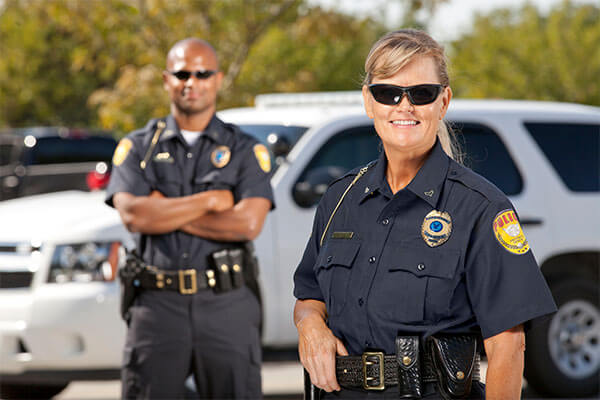
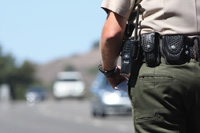 In an experiment to test citizen behavior, a male researcher randomly approached pedestrians and gave them one of three orders: to pick up a paper bag littering the sidewalk, to give a dime to another passerby, or to step back from a bus stop. During the course of the experiment, the researcher wore either ordinary casual clothing, milk delivery apparel or a gray police-style uniform with a badge but no weapons. Only when the researcher wore the police-style uniform did people consistently cooperate and obey the order. In fact, their obedience continued even after he walked around the corner, not staying to observe or enforce compliance.
In an experiment to test citizen behavior, a male researcher randomly approached pedestrians and gave them one of three orders: to pick up a paper bag littering the sidewalk, to give a dime to another passerby, or to step back from a bus stop. During the course of the experiment, the researcher wore either ordinary casual clothing, milk delivery apparel or a gray police-style uniform with a badge but no weapons. Only when the researcher wore the police-style uniform did people consistently cooperate and obey the order. In fact, their obedience continued even after he walked around the corner, not staying to observe or enforce compliance.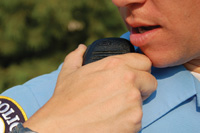 And in a third research project, when an individual wearing a police-style uniform stood on a sidewalk near a corner, drivers committed fewer turn violations at that intersection. This occurred even though the uniform did not represent a real police department in the area and the man did not display a badge or weapon.
And in a third research project, when an individual wearing a police-style uniform stood on a sidewalk near a corner, drivers committed fewer turn violations at that intersection. This occurred even though the uniform did not represent a real police department in the area and the man did not display a badge or weapon.
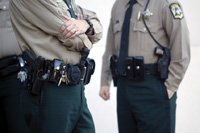 Not only will people expect someone in an officer’s uniform to take charge, they’ll expect that person to take notice. “A police uniform says, Don’t do anything wrong,'” according to Steve Leventhal of Leventhal Ltd., manufacturer of law enforcement uniforms. “The police uniform has to be recognizable, so it gives a sense of comfort to most people and a sense of distress to those people who may want to cause distress.”
Not only will people expect someone in an officer’s uniform to take charge, they’ll expect that person to take notice. “A police uniform says, Don’t do anything wrong,'” according to Steve Leventhal of Leventhal Ltd., manufacturer of law enforcement uniforms. “The police uniform has to be recognizable, so it gives a sense of comfort to most people and a sense of distress to those people who may want to cause distress.”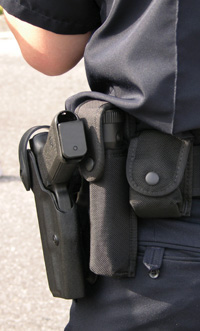 Police Uniform as Instant Messaging
Police Uniform as Instant Messaging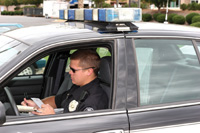 “In certain scenarios, almost all police officers would immediately draw their weapon on people wearing jeans and a T-shirt and carrying a gun in their hand. A plainclothes officer chasing a burglary suspect through backyards at night risks being shot by a home owner who believes the officer is a criminal. The uniform helps both citizens and fellow police officers identify the wearer as having a legitimate purpose for trespassing, using force or carrying a weapon,” according to Johnson.
“In certain scenarios, almost all police officers would immediately draw their weapon on people wearing jeans and a T-shirt and carrying a gun in their hand. A plainclothes officer chasing a burglary suspect through backyards at night risks being shot by a home owner who believes the officer is a criminal. The uniform helps both citizens and fellow police officers identify the wearer as having a legitimate purpose for trespassing, using force or carrying a weapon,” according to Johnson.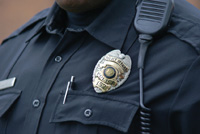 Blue is the ideal color for police uniforms, according to Keith Renfroe, a clinical psychologist who was formerly a correctional officer deputy sheriff and wore a uniform of dark blue pants and light blue shirt with a light blue stripe down the side.
Blue is the ideal color for police uniforms, according to Keith Renfroe, a clinical psychologist who was formerly a correctional officer deputy sheriff and wore a uniform of dark blue pants and light blue shirt with a light blue stripe down the side.






